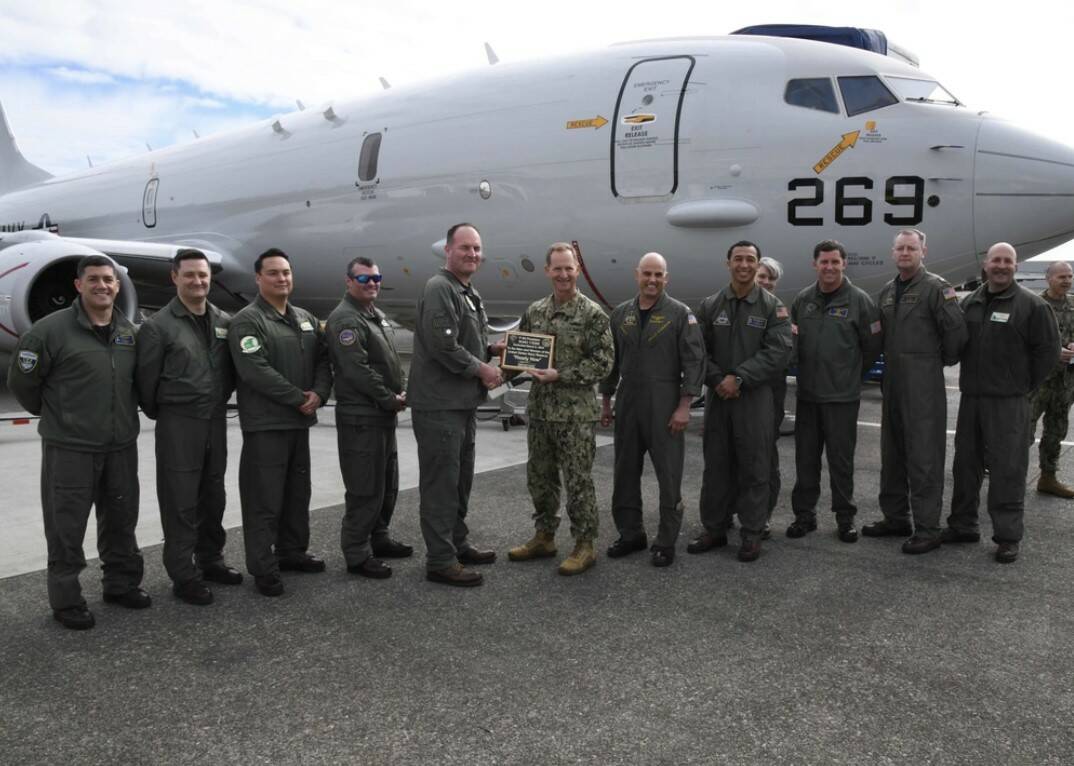With Houthi attacks in the Red Sea, Chinese and Philippine coast guard collisions in the South China Sea and North Atlantic Treaty Organization expansion on the Baltic and Black seas, the Naval Air Force Reserve’s new squadron of the P-8 Poseidon has its work cut out.
“The missions that the United States needs to participate in are all predicated on the availability of these airplanes,” said Naval Air Force Reserve Chief Vice Admiral John Mustin.
Mustin touched down on Naval Air Station Whidbey Islamd Wednesday, sending a P-8 fresh off the Boeing assembly line to the Reserve base in Jacksonville, Florida. This is the first of 11 aircraft, split in two squadrons between Whidbey and Jacksonville, in a historic allocation of equipment to the Reserve.
The P-8 Poseidon is basically a militarized 737. Armed with torpedoes, harpoons, anti-ship missiles and sonobuoys, the P-8 is the nation’s only airborne, long-range, multi-mission jet performing cue-to-kill anti-submarine warfare, anti-surface warfare and armed intelligence, surveillance, reconnaissance and targeting missions.
“If you’re trying to cover hundreds of thousands of square miles, it’s very hard to do that in low, slow flying airplanes, so having a jet that can do that is very helpful,” Mustin said, “and it just happens that this particular platform is the most capable of its type in any service in any country.”
Prior to this designation, the Naval Air Force Reserve utilized the P-3 Orion, introduced by Lockheed in 1962, which has since been retired. When the Reserve flew a P-8, it was through the Navy’s centrally managed inventory. Instead, these will be brand-new, purpose-built aircraft directly from the plant.
The P-8 is a big jump from the P-3, said Captain Sean Foertsch, director of Public Affairs for the Naval Air Force Reserve.
“It is historic for us because we’ve been operating aircraft that were almost 80 years (old),” he said. “This seems like light years ahead of what we had before.”
Each tail of the Whidbey squadron, VP-69, displays an indigenous totem symbol as an acknowledgement of the region. According to the Navy website, the totems symbolize family and teamwork.
Going to the Reserve does not mean these aircraft will be on standby, Mustin said. The squadrons will be operational 24/7/365. Additionally, P-8s will be used by the Third Fleet Commander in San Diego and the Rim of the Pacific warfare exercise every two years in Honolulu.
While a squadron typically consists of 12 aircraft, the Naval Air Force Reserve will have a total of 11. The Pentagon diverted $3.8 billion from its fiscal 2020 weapons procurement budget to fund then-President Donald Trump’s border wall, Defense News reports, with the VP-69 squadron being a victim of the cuts.
Whidbey and Jacksonville will attain their squadrons in full by Fiscal Year 2025. The first deployment will be out of Sigonella, Italy this summer, Mustin said.
Mustin is proud of the Naval Air Force Reserve’s partnership with Boeing, especially because of the quality of the new aircraft, he said.
“I love coming out to visit them because it’s always so inspiring,” he said. “Going to hear them talk about their pride in what they do and knowing that the latest and greatest brand-spanking-new, new plane smell kind of planes, are going to be available to (the Navy Reserve Force) too. It gives them new inspiration and more energy too.”



